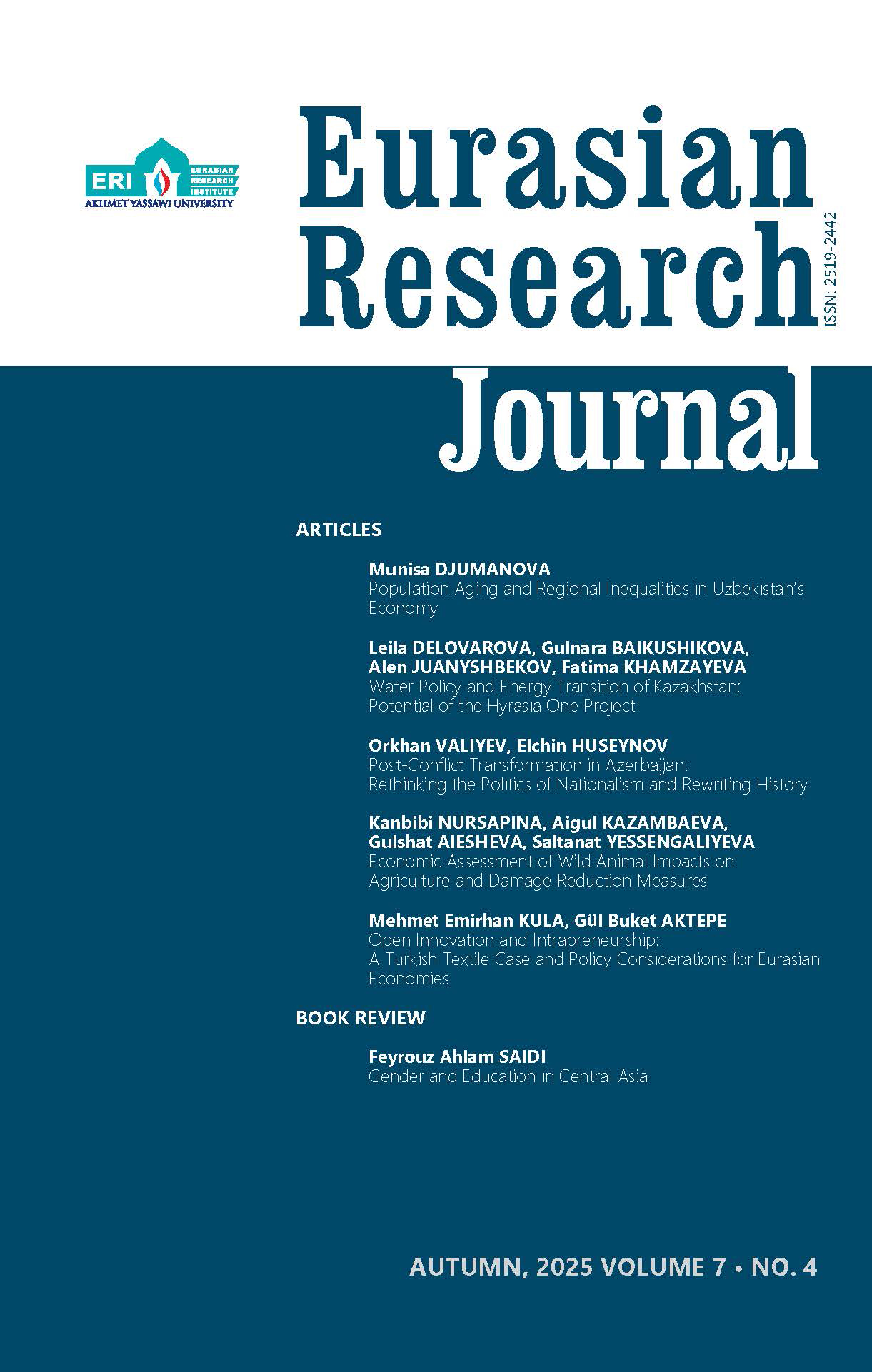Latest Issue
7 (4), 2025
 .
.
Editorial Board
Munisa DJUMANOVA
POPULATION AGING AND REGIONAL INEQUALITIES IN UZBEKISTAN’S ECONOMYThis paper examines the economic implications of Uzbekistan’s demographic transition by analyzing how population age structures, human capital, and regional disparities shape growth. Using municipal-level data from Uz.Stat (2000–2023) and econometric methods, it identifies the prime working-age group (35–49) as the main driver of productivity, while younger (0–19) and older (65+) cohorts create dependency pressures. Urban-rural divides further mediate these effects, with population density both constraining and enhancing economic performance. Educational attainment emerges as a crucial factor mitigating demographic pressures and supporting growth. The study highlights the need for targeted policies to harness Uzbekistan’s demographic dividend and manage aging challenges through investments in education, healthcare, and labor market reforms particularly for women and older workers offering insights for fostering inclusive and sustainable development across emerging economies.
Keywords: Demographic dividend, Population aging, Uzbekistan, Economic growth, Regional analysis
DOI : https://doi.org/10.53277/2519-2442-2025.4-01 [HTML]
WATER POLICY AND ENERGY TRANSITION OF KAZAKHSTAN: POTENTIAL OF THE HYRASIA ONE PROJECTwith water security. The country’s geographical location makes it dependent on its neighbors for water resources. Kazakhstan’s water policy is still in the development stage, and there are still gaps and problems that need to be addressed. Another important area for Kazakhstan is the energy transition, which has both economic and energy significance. The Hyrasia One project, a joint initiative of Kazakhstan, Germany, and China, can be a good solution in this context. The article examines the potential of the project, its ability to become a stepping-stone to international cooperation, a tool for energy sustainability, and an example of Kazakhstan’s capabilities in the field of water efficiency and regulation. The article discusses the risks and benefits that this particular project will bring to Kazakhstan and Central Asia in the economic, energy, and diplomatic sectors.
Keywords: Hyrasia One, Germany, China, Kazakhstan, Water diplomacy, Trans-Caspian route
DOI : https://doi.org/10.53277/2519-2442-2025.4-02 [HTML]
POST-CONFLICT TRANSFORMATION IN AZERBAIJAN: RETHINKING THE POLITICS OF NATIONALISM AND REWRITING HISTORYThis paper explores the dynamics of the politics of nationalism and historiography in Azerbaijan after the Second Karabakh War, focusing on the evolution of the history of nationalism in Azerbaijan by tracing its transformation over the past two centuries. The research specifically examines the impact of the colonial policy of Tsarist Russia and the Soviet Union on the writing of history and the formation of identity in Azerbaijan. The study suggests that the Victory in the Second Karabakh War required consideration of rewriting the history of the politics of nationalism. In this sense, the decolonizing of the historiography is important. To protect its sovereignty and independence from the neocolonial tendencies, Azerbaijan should escape from the colonial way of historiography and the colonial definition of national identity. In this context, rethinking nationalism implies redefining Azerbaijan’s identity into a new form, which is embracing Turkishness as a constituent part while reflecting its multicultural pattern.
Keywords: Nationalism, National identity, ADR, Karabakh, Azerbaijani Historiography
DOI : https://doi.org/10.53277/2519-2442-2025.4-03 [HTML]
ECONOMIC ASSESSMENT OF WILD ANIMAL IMPACTS ON AGRICULTURE AND DAMAGE REDUCTION MEASURESThis article assesses how the combined effects of rapid agricultural land‑use expansion and the saiga (Saiga tatarica) migrations influence Kazakhstan’s agricultural sector and evaluates sustainable land‑use solutions that reconcile production and biodiversity goals. Drawing on data from the Ministry of Ecology and field studies in the West Kazakhstan, Atyrau, and Kyzylorda regions, we quantify direct financial losses from crop damage, costs of restoring fences, irrigation and farm buildings, as well as foregone yields. Spatial analysis and statistical modeling identify three “hot” vulnerability clusters and seasonal loss dynamics (up to 60% in summer, ~16% in spring). The research spans five annual migration cycles and incorporates stakeholder consultations with farmers and conservation authorities to refine interventions. Practice-oriented measures are proposed – protected migration corridors aligned with traditional routes, farmer compensation schemes and integrated population- management strategies (scientific monitoring, local co-management, economic incentives) – to harmonize biodiversity conservation with sustainable agriculture.
Keywords: Saiga antelopes, Economic damage, Agriculture, Migratory corridors, Compensation, Population management
DOI : https://doi.org/10.53277/2519-2442-2025.4-04 [HTML]
OPEN INNOVATION AND INTRAPRENEURSHIP: A TURKISH TEXTILE CASE AND POLICY CONSIDERATIONS FOR EURASIAN ECONOMIESSustainability challenges in a globalized world have driven businesses, particularly in the Eurasian textile sector, to adopt open innovation for competitive advantage. This study examines the effects of inside-out and outside-in open innovation on intrapreneurship (innovativeness, risk-taking, proactiveness, autonomy) in garment and apparel manufacturing in Erzurum, offering broader insights for Eurasian economies. Survey data from 244 participants were analyzed using Pearson correlation, multiple regression, t-test, and ANOVA. The findings reveal that outside-in open innovation enhances innovation, while inside-out open innovation has stronger effects on risk-taking, proactiveness, and autonomy. This suggests that external knowledge integration fosters creativity, while knowledge sharing strengthens entrepreneurial behavior. Beyond Erzurum, the study highlights policy implications for Türkiye, Kazakhstan, Uzbekistan, and Azerbaijan, emphasizing the need for stronger R&D collaboration, cross-border innovation networks, and supportive policies to drive innovation-led growth in the textile sector. Businesses are encouraged to adopt open innovation strategies to enhance employee creativity, competitiveness, and regional economic development.
Keywords: Entrepreneurship, Intrapreneurship, Open innovation, Inside-out open innovation, Outside-in open innovation, Eurasian textile sector
DOI : https://doi.org/10.53277/2519-2442-2025.4-05 [HTML]
Book Review: GENDER AND EDUCATION IN CENTRAL ASIA
